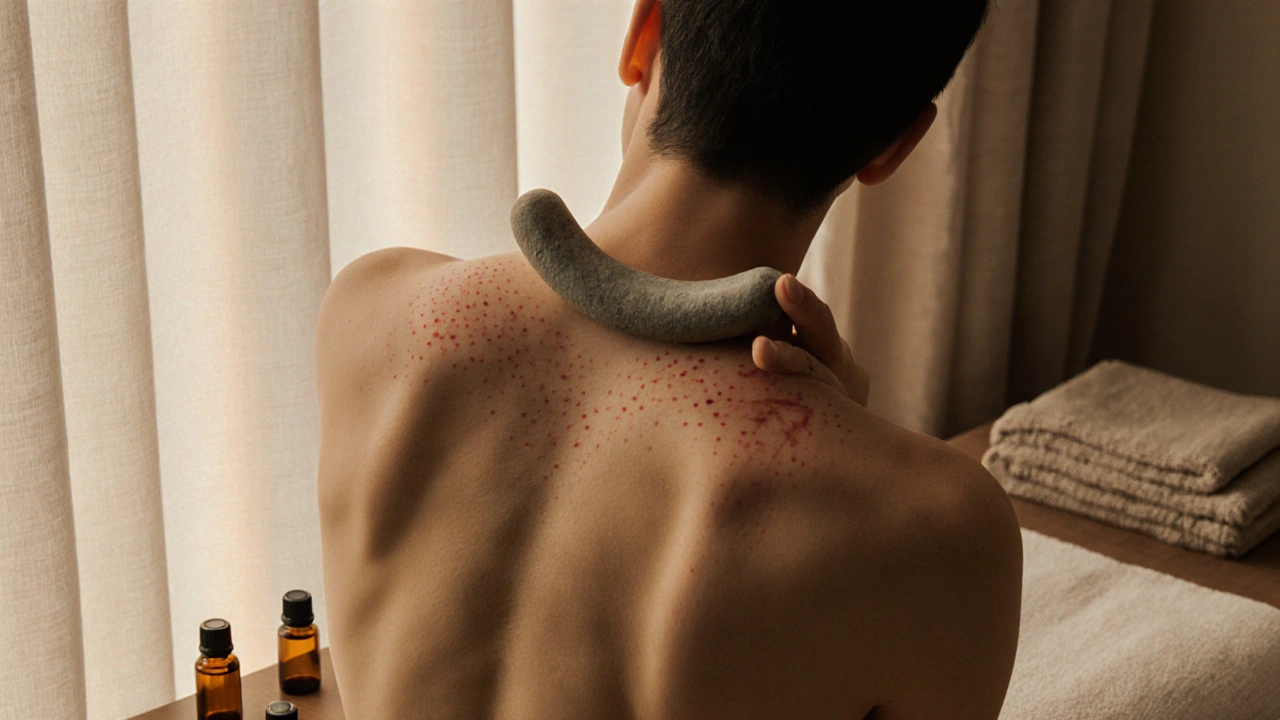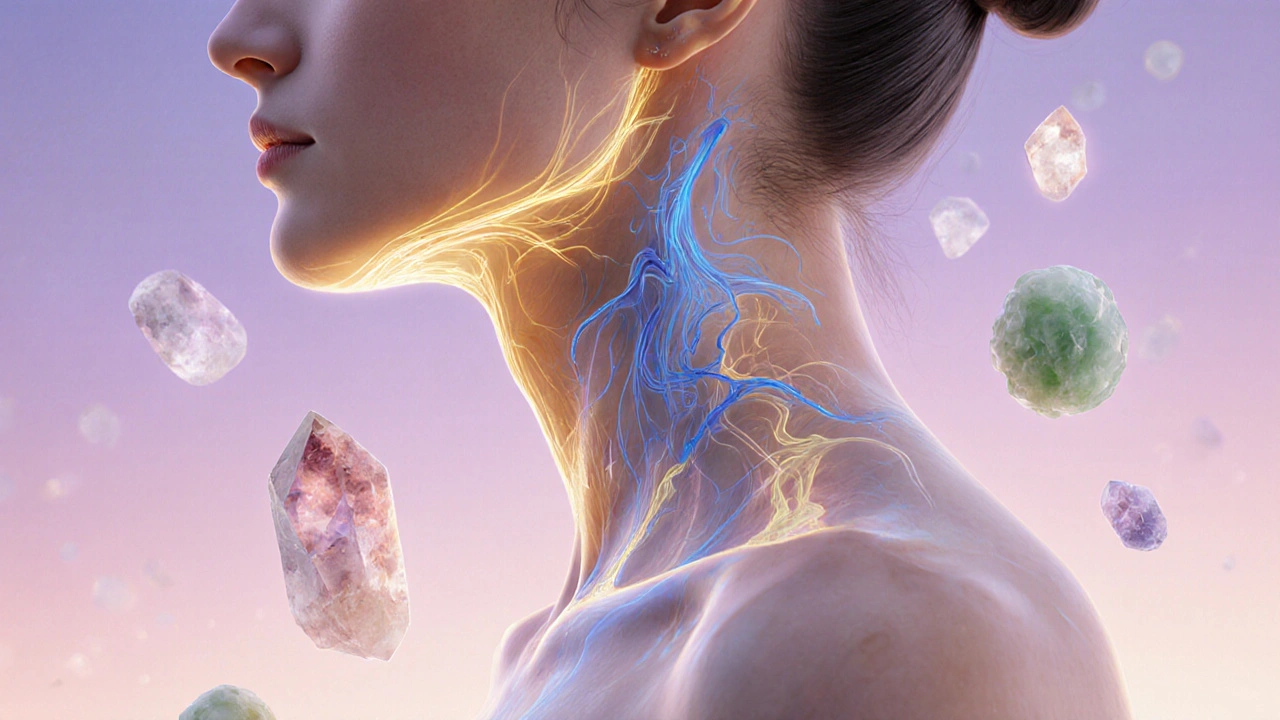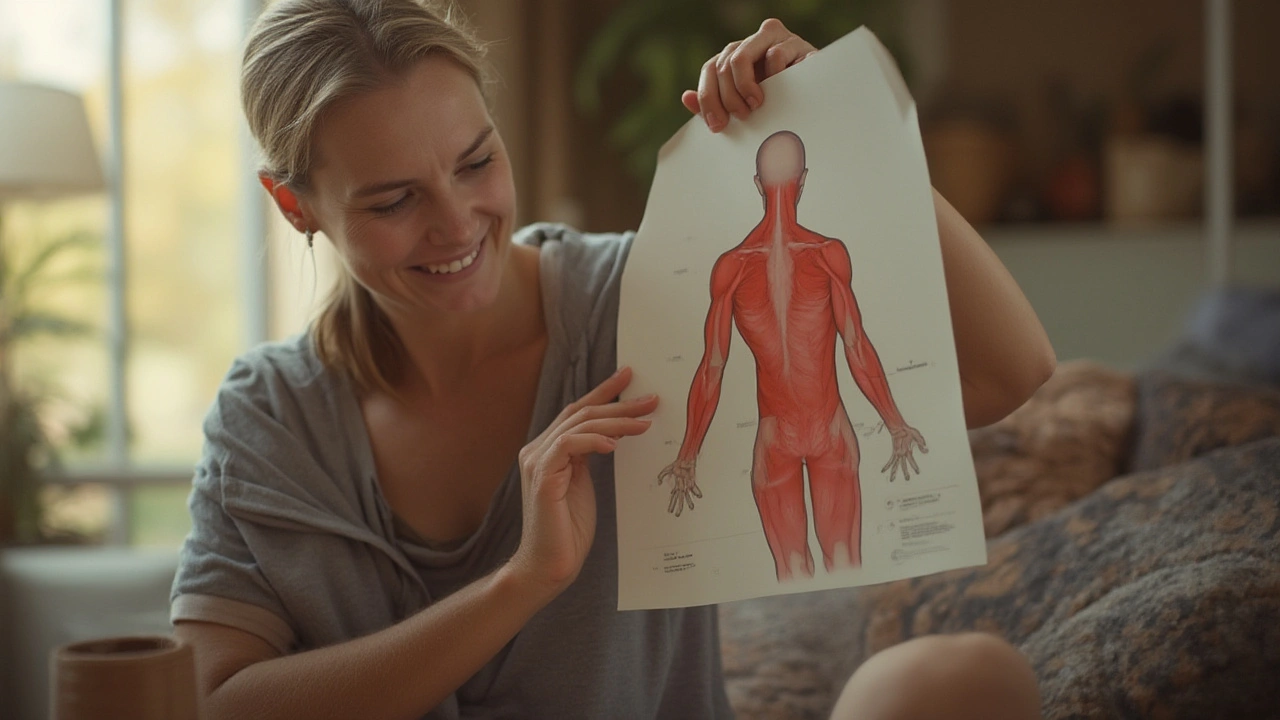Gua Sha: The Ancient Chinese Technique for Facial and Body Wellness

Gua Sha Frequency Calculator
Personalize Your Routine
Get tailored recommendations for your gua sha practice based on your skin type, goals, and schedule
Your Gua Sha Schedule
Key Benefits
- Reduced facial puffiness
- Improved circulation
- Muscle tension relief
Ever looked in the mirror after a long day and noticed your face looked swollen, dull, or tense? You’re not alone. Millions of people wake up with jaw clenching, forehead tension, or puffiness under the eyes-often from stress, poor sleep, or just staring at screens too long. What if a simple tool, used for over 2,000 years in China, could help reset that? Enter gua sha.
What Exactly Is Gua Sha?
Gua sha (pronounced "gwa-sha") comes from two Chinese words: gua, meaning to scrape or rub, and sha, referring to the reddish petechiae (tiny spots) that sometimes appear on the skin. It’s not about drawing blood or causing bruising-it’s about gently moving the skin over muscle and fascia to release tension and improve circulation.
In traditional Chinese medicine, gua sha is used to move qi (energy) and clear blockages believed to cause pain, inflammation, or stagnation. But you don’t need to believe in energy channels to see results. Modern research shows it increases local blood flow, reduces muscle stiffness, and lowers inflammatory markers like IL-6 and TNF-alpha.
It’s not just for the body. Facial gua sha has exploded in popularity over the last five years, thanks to social media and celebrity endorsements. But this isn’t just another skincare trend-it’s a centuries-old practice with real physiological effects.
How Gua Sha Works on Your Skin and Muscles
When you glide a smooth tool across your skin-usually with oil or serum-you’re not just massaging the surface. You’re stimulating the connective tissue beneath, called fascia. Fascia wraps around muscles, organs, and nerves. When it gets tight from stress or repetitive motion, it pulls on surrounding structures, causing pain or puffiness.
Gua sha gently stretches and releases that fascia. The pressure triggers a mild inflammatory response, which sounds bad-but it’s actually healing. Your body sends more blood, oxygen, and immune cells to the area. That’s why your skin might turn slightly red or pink after a session. It’s not damage. It’s activation.
On the face, this helps drain excess fluid that causes puffiness, especially around the eyes and jawline. Many users report a more defined jawline, reduced forehead lines, and brighter skin after just a few weeks of consistent use.
Tools You Need (And What to Avoid)
You don’t need fancy gadgets. Traditional gua sha tools are made from jade, rose quartz, or bian stone-a type of heated, polished stone used in ancient China. Today, you’ll find them in shapes like boats, spoons, or hearts. The key is smooth edges and a comfortable grip.
Here’s what works best:
- Jade: Naturally cool, great for reducing inflammation and calming redness. Ideal for sensitive skin.
- Rose quartz: Slightly warmer than jade, believed to promote emotional balance (though scientifically, it’s just a pretty stone).
- Bian stone: Rare and expensive, traditionally heated and used in clinical settings. Not necessary for home use.
Avoid plastic tools. They bend, don’t glide well, and can harbor bacteria. Also skip tools with sharp edges or pointed tips-those are for acupressure, not gua sha.
Most people start with a basic jade gua sha tool under $20. You don’t need to spend more unless you’re collecting them.

How to Do Gua Sha on Your Face (Step by Step)
Start with clean skin and a facial oil-jojoba, rosehip, or squalane work well. Never do gua sha on dry skin; it causes micro-tears.
- Apply 3-5 drops of oil to your face and neck.
- Hold the tool at a 15-30 degree angle to your skin. Don’t press hard. Let the weight of the tool do the work.
- Start at the center of your face and move outward.
- Use slow, steady strokes-no quick scraping.
- Repeat each stroke 3-5 times before moving to the next area.
Here’s the sequence:
- Jawline: Start under your ear, glide down to your collarbone. This helps drain lymph.
- Cheeks: From the nose outward toward the ears.
- Under eyes: Use the small curved edge. Gently stroke from inner corner to temple.
- Forehead: From the center outward toward the temples.
- Neck: Always finish here. Stroke from chin down to collarbone to encourage drainage.
Do this for 5-10 minutes, 3-4 times a week. You’ll notice less puffiness in the morning within a week. After a month, many users say their skin looks firmer and more radiant-even without new products.
Gua Sha for the Body: Beyond the Face
Facial gua sha gets all the attention, but body gua sha is where it really shines for pain relief. Athletes, office workers, and people with chronic tension swear by it.
Use a larger tool-like a curved spoon or wide paddle-for the back, shoulders, and legs. Apply the same technique: oil, light pressure, slow strokes along muscle fibers.
Try it on:
- Upper back: Between the shoulder blades-great for stress buildup.
- Calves: Helps with cramps and tightness from sitting or running.
- Neck and trapezius: Reduces tension headaches.
One 2023 study published in the Journal of Bodywork and Movement Therapies found that participants with chronic neck pain who used gua sha three times a week for four weeks reported a 42% reduction in pain levels-compared to just 11% in the control group who only stretched.
What Gua Sha Won’t Do
It’s important to set realistic expectations. Gua sha isn’t magic.
- It won’t erase deep wrinkles.
- It won’t replace Botox or fillers.
- It won’t make your face smaller permanently.
What it does do is improve skin texture, reduce temporary puffiness, and ease muscle tension. Think of it like a deep-tissue massage for your face and body-except you can do it yourself while watching TV.

Who Should Avoid Gua Sha?
Most people can safely use gua sha. But skip it if you have:
- Active acne, open sores, or sunburn
- Blood thinners or clotting disorders
- Recent surgery or implants in the area
- Severe rosacea or eczema flare-ups
- Feeling unwell or feverish
If your skin turns purple or bruised, you’re pressing too hard. Gua sha should feel like a firm, soothing pressure-not painful.
Why It’s Gaining Traction Outside China
Western medicine didn’t pay attention to gua sha for decades. But as more people seek non-drug ways to manage pain and stress, practitioners are taking notice.
Physical therapists in Australia and the U.S. now include it in treatment plans for headaches, TMJ, and postural pain. Dermatologists are studying its effect on skin barrier function. And spas from Sydney to San Francisco now offer gua sha as part of their facial packages.
It’s not replacing acupuncture or herbal medicine. But as a simple, low-cost, self-care tool? It’s hard to beat.
Getting Started: A Simple Routine
Here’s what a beginner routine looks like:
- Monday/Wednesday/Friday: 5-minute facial gua sha after cleansing.
- Tuesday/Thursday: 10-minute body gua sha on shoulders and neck.
- Saturday: Optional longer session-add a warm towel before to open pores.
- Sunday: Rest. Let your skin recover.
Keep your tool clean. Wash it with mild soap and water after each use. Store it in a dry place. Replace it if it chips or cracks.
Many people say they feel calmer after using gua sha-not just because their face looks better, but because the ritual slows them down. In a world full of noise, five minutes of quiet, intentional touch can be healing.
Can gua sha really reduce wrinkles?
Gua sha doesn’t remove wrinkles. But it can make fine lines appear less noticeable by improving circulation and skin elasticity. Regular use increases collagen production over time, which helps skin look plumper and smoother. It’s a supportive tool, not a replacement for retinoids or professional treatments.
How often should I use gua sha?
For the face, 3-4 times a week is ideal. Daily use is fine if your skin isn’t sensitive. For the body, 2-3 times a week is enough, especially if you’re targeting sore muscles. Listen to your skin-if it’s red or tender, take a day off.
Do I need to use oil with gua sha?
Yes. Never do gua sha on dry skin. Oil reduces friction and lets the tool glide smoothly. Without it, you risk irritating or tearing delicate skin. Choose a lightweight facial oil-jojoba, squalane, or grapeseed work best. Avoid heavy creams that clog the tool.
Is gua sha the same as a facial roller?
No. Rollers are great for cooling and depuffing, but they don’t provide the same deep fascial release as gua sha. Gua sha tools are shaped to follow contours and apply directional pressure, which helps drain lymph and release muscle tension. Rollers are gentler; gua sha is more targeted.
Can I use gua sha if I have sensitive skin?
Yes, but be extra gentle. Use a jade tool-it’s naturally cooling-and reduce pressure. Avoid areas with active breakouts or rashes. Start with once a week and increase only if your skin reacts well. Patch test first if you’re prone to reactions.
How long until I see results?
Most people notice reduced puffiness within 3-5 days. Skin glow and texture improvements usually show up after 2-4 weeks of consistent use. For muscle relief, pain reduction can happen after just one session. Like any self-care practice, consistency matters more than intensity.





